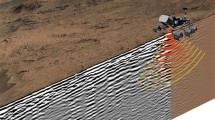Summary
Based upon new data and re-analysis of previous data, some results concerning migration of “birds” at night are now attributed to insects. In particular, slowly flying radar targets over land (Larkin and Thompson 1980) and, by analogy, over the ocean (Larkin et al. 1979) are shown to lack wing beat patterns of birds and the appearance of birds when viewed with a radar-controlled high-power telescope and spotlamp. The insect targets overlap with birds in the amount of radar echo returned, are abundant in warmer months, and fly even in March and November in temperate North America. Other previous results are largely substantiated; however, a previous report (Larkin 1980) that migrating birds can detect the wind direction over the ocean is not substantiated.
Similar content being viewed by others
References
Able KP (1974) Wind, track, heading, and the flight orientation of migrating songbirds. In: Gauthreaux SA (ed) The biological aspects of the bird/aircraft collision problem. Air Force Office of Scientific Research, Clemson SC, pp 331–357
Bachman H (1966) Boezeberg-Rapport 1964, das Auftreten von Nachtfaltern am Boezeberg im Jahre 1964. Mitt Entomol Ges Basel 17-75
Bloch R, Bruderer B (1982) The air speed of migrating birds and its relationship to the wind. Behav Ecol Sociobiol 11:19–24
Bloch R, Bruderer B, Steiner P (1981) Flugverhalten nächtlich ziehender Vögel. Radardaten über Zug verschiedener Vogeltypen auf einem Alpenpass. Vogelwarte 31:119–149
Bowden J, Johnson CG (1976) Migrating and other terrestrial insects at sea. In: Cheng L (ed) Marine insects. North-Holland, pp 97-117
Bruderer B, Joss J (1969) Methoden and Probleme der Bestimmung von Radarquerschnitten frei fliegender Vögel. Rev Suisse Zool 76:1106–1118
Crawford AB (1949) Radar reflections in the lower atmosphere. Proc Inst Radio Eng 37:404–405
Drake VA, Farrow RA (1985) A radar and aerial-trapping study of an early spring migration of moths (Lepidoptera) in inland New South Wales. Aust J Ecol 10:223–235
Drake VA, Helm KF, Readshaw JL (1981) Insect migration across Bass Strait during spring: a radar study. Bull Ent Res 71:449–466
Emlen ST (1974) Problems in identifying bird species by radar signature analyses: intra-specific variability. In: Gauthreaux SA (ed) The biological aspects of the bird/aircraft collision problem. Air Force Office of Scientific Research, Clemson SC, pp 509–524
Farrow RA, Dowse JE (1984) Method of using kites to carry tow nets in the upper air for sampling migrating insects and its applications to radar entomology. Bull Ent Res 74:87–95
Griffin DR, Thompson D (1982) High altitude echolocation of insects by bats. Behav Ecol Sociobiol 10:303–306
Griffin DR, Larkin RP, Torre-Bueno JR (1974) Changes in flight patterns of birds induced by searchlight beams. In: Gauthreaux SA (ed) The biological aspects of the bird/aircraft collision problem. Air Force Office of Scientific Research, Clemson SC, pp 422–427
Illinois Natural History Survey, Illinois State Water Survey (1987) The pests and weather project. Report ILEND/RE-AQ-87/01 Illinois Dept Energy and Natural Resources, Springfield IL
Larkin RP (1979) An algorithm for assessing bimodality versus unimodality in a univariate distribution. Behav Methods Instrument 11:467–468
Larkin RP (1980) Transoceanic bird migration: evidence for detection of wind direction. Behav Ecol Sociobiol 6:229–232
Larkin RP (1984) ELF communications system ecological monitoring program: field studies of effects of ELF on migrating birds. In: Compilation of 1983 annual reports of the Navy ELF communications system ecological monitoring program. Technical report E06549-8, US Naval Systems Command, Washington DC 2:(J)
Larkin RP, Eisenberg L (1978) A method for automatically detecting birds on radar. Bird-Banding 49(2):172–181
Larkin RP, Frase BA (1988) Circular paths of birds flying near a broadcasting tower in cloud. J Comp Psychol 102:90–93
Larkin RP, Quine DB (1987) Report on bird movement data. US Army CERL Contract DACA88-86-0001, 73 pp.
Larkin RP, Thompson D (1980) Flight speeds of birds observed with radar: evidence for two phases of migratory flight. Behav Ecol Sociobiol 7:301–317
Larkin RP, Torre-Bueno JR, Griffin DR, Walcott C (1975) Reactions of migrating birds to lights and aircraft. Proc Natl Acad Sci 72:1994–1996
Larkin RP, Griffin DR, Torre-Bueno JR, Teal J (1979) Radar observation of bird migration over the Western North Atlantic Ocean. Behav Ecol Sociobiol 4:225–264
Mueller EA, Larkin RP (1985) Insects observed using dual-polarization radar. J Atmos Oceanic Technol 2:49–54
Murray BG (1989) A critical review of the transoceanic migration of the Blackpoll Warbler. Auk 106:8–17
Riley JR (1973) Angular and temporal variations in the radar crosssections of insects. Proc IEE 120:1229–1232
Riley JR (1989) Remote sensing in entomology. Annu Rev Entomol 34:247–271
Riley JR, Reynolds DR (1986) Orientation at night by high-flying insects. In: Danthanarayana W (ed) Insect flight: dispersal and migration. Springer, Berlin Heidelberg New York, pp 72–87
Schaefer GW (1976) Radar observations of insect flight. In: Rainey RC (ed) Insect flight. Symp R Entomol Soc Lond 7:157–197
Vaughn CR (1974) Intraspecific wingbeat rate variability and species identification using tracking radar. In: Gauthreaux SA (ed) The biological aspects of the bird/aircraft collision problem. Clemson, SC, pp 443–476
Vaughn CR (1985) Birds and insects as radar targets: a review. Proc IEEE 73:205–227
Williams TC, Williams JM (1978) Orientation of transatlantic migrants. In: Schmidt-Koenig K, Keeton W (eds) Animal migration, orientation, and homing. Springer, Berlin Heidelberg New York, pp 239–251
Author information
Authors and Affiliations
Rights and permissions
About this article
Cite this article
Larkin, R.P. Flight speeds observed with radar, a correction: slow “birds” are insects. Behav Ecol Sociobiol 29, 221–224 (1991). https://doi.org/10.1007/BF00166405
Received:
Accepted:
Issue Date:
DOI: https://doi.org/10.1007/BF00166405




